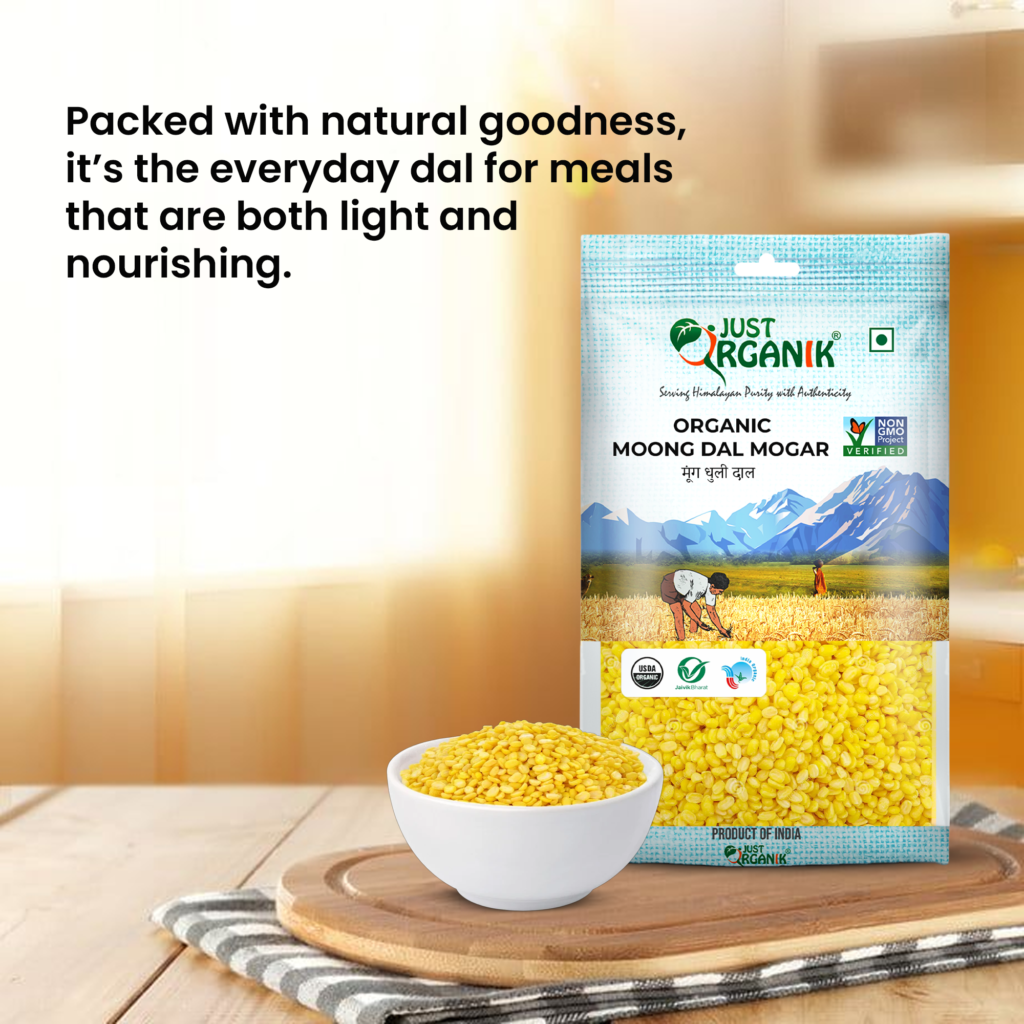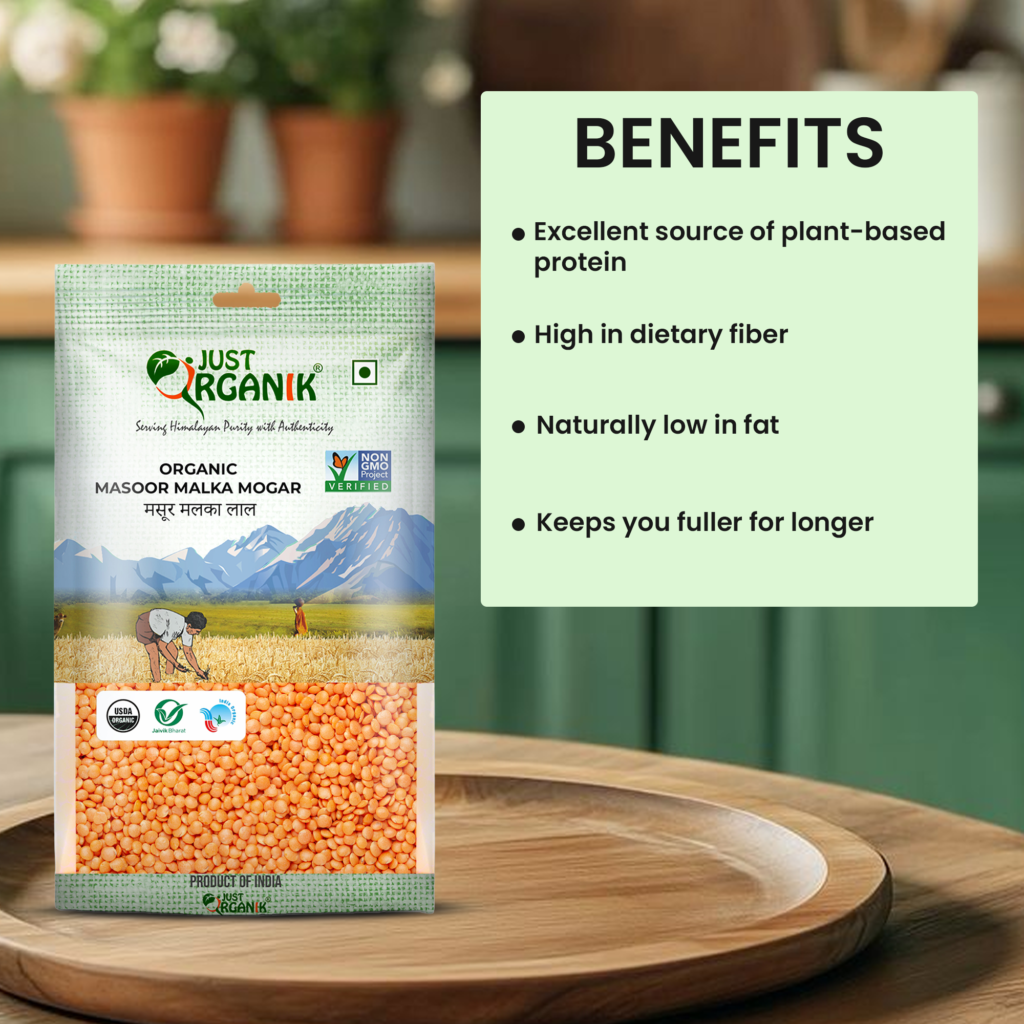In every Indian kitchen, dal is more than just a dish it’s an emotion. A bowl of warm dal-chawal after a long day, the comforting aroma of tadka, or the familiar sound of pressure cookers hissing in the background these are memories we all share.
At Just Organik, we believe in preserving not just the nutrition but also the nostalgia of these everyday staples. That’s why we grow all our organic dals naturally, process them minimally, and pack them with care—so you enjoy pure taste, better nutrition, and zero compromises.
What Makes Just Organik kitchen Dals Better?
- 100% Certified Organic:
No chemicals, no synthetic fertilizers, and no GMOs — just pure food, as nature intended. - Grown Sustainably:
Our dals come from certified organic farms across India, supporting rural livelihoods and ecological balance. - Unpolished Goodness:
Unlike mass-market polished dals, we retain the natural outer layer, preserving fiber, taste, and nutrition. - Rigorous Quality Checks:
Every batch is lab-tested for purity, quality, and safety — so what reaches your kitchen is clean and trusted. - Packed with Purpose:
Eco-conscious packaging that preserves freshness while reducing environmental impact.
Understanding the Differences: Malka, Mogar, Dhuli, Split & Whole
Indian dals come in many forms, and terms like Malka, Mogar, Dhuli, Split, and Whole often confuse even experienced cooks. Let’s break it down in simple terms:
- Whole dals are the most natural form — like whole moong or kala chana — with the skin on and grain intact.
- Split dals are broken versions of whole dals but still keep their outer skin. Moong chilka and chana dal are great examples.
- Dhuli dals are split and dehusked. You’ll see their clean, polished look — like moong dhuli (yellow) or urad dhuli (white).
- Mogar is another name for yellow moong dal — split and without skin. People often use this name in Gujarat and Rajasthan.
- Malka dal means split red lentils. These come from whole masoor but lose their skin, turning into flat, peach-colored lentils.
Each type brings a unique texture and taste to Indian dishes. Knowing the difference helps you cook the right dal for the right occasion — whether it’s a creamy khichdi, crispy chilla, or hearty curry.
Each type cooks differently, tastes slightly different, and suits different dishes — but all are rich in protein and a core part of Indian kitchens.
Our Organic Dal Range: For Every Indian Kitchen
Here’s a look at the variety we offer — each one with its own flavour, texture, and nutrition profile:
Moong Dal Dhuli (Yellow Split Moong)
Moong Dal Dhuli is the split and dehusked version of green gram (whole moong). Once the green husk is removed, the inner seed is split into two flat, yellow lentils. It’s extremely popular across Indian households for its fast-cooking nature and lightness on the stomach.
It has a mild, slightly sweet flavor and a creamy texture once cooked — making it ideal for people of all age groups. Just Organik’s Moong Dal Dhuli is unpolished and organically grown, preserving its natural nutrition.

Ayurvedic View:
In Ayurveda, moong dal is considered tridoshic — it balances all three doshas (Vata, Pitta, Kapha). It’s sattvic in nature, promoting clarity and calmness. Moong is especially recommended for:
- Cleansing diets
- Post-illness recovery
- Spiritual or fasting food
It is cooling and nourishing — gentle enough for the most sensitive digestive systems.
Health Benefits:
- Easy to Digest:
Its low fiber content (due to dehusking) makes it suitable for those with weak digestion, IBS, or recovering from illness. - High in Plant Protein:
Supports muscle repair and overall growth, especially important in vegetarian/vegan diets. - Good for Heart Health:
Low in fat and rich in antioxidants, it helps in reducing inflammation and supports cardiovascular health. - Diabetic-Friendly:
Its low glycemic index and protein content help regulate blood sugar levels. - Ideal for Weight Loss:
High protein and moderate fiber content keeps you fuller longer, reduces snacking.
Cultural & Regional Use in India:
- In North India, it’s used for simple dal with jeera tadka, or in khichdi with rice and ghee.
- In South India, it may be substituted for toor dal in light sambars or rasams during recovery.
- In Gujarati cuisine, moong dal is used in puran poli or sweet dal preparations.
- Common in fasting foods like moong dal chilla or light upwas khichdi.
It is often the first dal introduced to babies after 6 months of age.
How to Cook It:
Basic Prep:
- No soaking needed, but a 15–20 minute soak helps cook faster and reduces bloating for sensitive people.
- Wash thoroughly 2–3 times until water runs clear.
To Cook (1 cup dal):
- Pressure cook with 2.5 to 3 cups water for 2 whistles.
- Or cook in a pot with 3.5 cups water, 20–25 minutes simmer.
Popular Recipes:
- Moong Dal Tadka with ghee, jeera, hing, and green chilli
- Moong Dal Khichdi (with rice, turmeric, and mild spices)
- Moonglet (savory pancake made with ground moong dal batter)
- Moong Dal Halwa (traditional winter sweet)
Toor Dal / Arhar Dal (Split Pigeon Pea)
Arhar or Toor Dal is a staple in most Indian homes, especially in the western and southern parts of India. It has a dense, creamy texture and a rich earthy flavor, making it perfect for hearty meals. Just Organik’s Arhar Dal is unpolished and organically cultivated, without chemicals or synthetic processing.
Ayurvedic View:
Balances Vata and Kapha. Slightly warming and strengthening in nature. Enhances stamina and tissue repair.
Health Benefits:
- Protein-Dense – Excellent source of protein for daily consumption.
- Iron-Rich – Supports energy and hemoglobin levels.
- Filling Yet Light – Ideal for daily dal-rice meals.
- Good for Gut – Contains complex carbs and some fiber.
- Energy Builder – Traditionally known to support strength and immunity.
Cultural Use:
- South India: Used in sambar and rasam.
- Maharashtra: Varan-bhaat (simple dal-rice combo with ghee).
- Bihar & UP: Slightly spiced arhar dal with jeera tadka.
- Gujarat: Slightly sweet-and-sour dal.
How to Cook It:
Soak for 30 minutes then Pressure cook 1 cup dal with 3 cups water for 3–4 whistles and add turmeric while boiling for added effect.
Urad Dal (Split Black Gram)
Urad dal, especially the split and dehusked version (white), is a heavier lentil with a rich, earthy flavor. It’s deeply rooted in Indian culinary traditions — from dals to fermented batters for idli and dosa. Just Organik’s Urad Dal is organically grown, free from artificial polishing.
Ayurvedic View:
Heats the body and strengthens tissues. Traditionally used to build strength and bone density. Best paired with warming spices like ginger and hing.
Health Benefits:
- Bone-Strengthening – Contains calcium, magnesium, and iron.
- Excellent Protein Source – Especially in vegetarian diets.
- Boosts Stamina – Traditionally used in winter recipes for strength.
- Aids Digestion (when tempered right) – Hing and cumin make it more digestible.
- Improves Skin & Hair – Traditionally believed to support vitality.
Cultural Use:
- South India: Idli-dosa batter, medu vada.
- North India: Dal Makhani (whole urad), simple urad dal tadka.
- Punjab: Rich lentil dishes with butter or cream.
How to Cook It:
Split urad cooks faster than whole. Soak 30 mins, pressure cook with 3 cups water for 3–4 whistles.
For whole urad (dal makhani), soak overnight and cook for 25–30 minutes minimum.
Masoor Dal (Red Lentils)
Masoor Dal is the red-orange lentil that cooks fast and breaks down into a soft, mushy texture. It’s especially loved for its comforting feel and ability to absorb spices well. Just Organik’s Masoor Dal is organic and unpolished, retaining its full mineral profile.
Ayurvedic View:
Balances Kapha and Pitta. Slightly warming and building in nature. Especially recommended during monsoons and cooler months.
Health Benefits:
- Fast Cooking – Saves time without compromising nutrition.
- Rich in Iron & Folate – Great for growing children and menstruating women.
- Good for Immunity – Zinc and antioxidants help fight infections.
- Easy on the Stomach – Light but nutritious, especially with a mild tadka.
- Heart-Healthy – Helps regulate cholesterol.

Cultural Use:
- Bengali-style masoor dal with mustard oil tadka.
- North Indian masoor dal with tomatoes, garlic, and coriander.
- Used in soups, stews, or combined with vegetables.
How to Cook It:
Rinse and pressure cook 1 cup with 2.5 cups water for 2 whistles. No soaking required.
Chana Dal (Split Bengal Gram)
Chana Dal is made by splitting and polishing the brown chickpea (desi chana). It has a bright yellow colour, nutty taste, and firm texture — perfect for dishes that need bite and bold flavor. Just Organik’s Chana Dal is grown organically and processed without chemicals.
Ayurvedic View:
Strength-giving and grounding. Balances Kapha. Builds stamina. Often included in post-delivery diets for women.
Health Benefits:
- Very High in Protein & Fiber – Keeps you full longer.
- Great for Diabetics – Complex carbs help maintain blood sugar.
- Improves Gut Health – Resistant starch helps gut flora.
- Supports Weight Loss – Low glycemic and highly satiating.
- Iron & B-Vitamins – Supports energy metabolism.
Cultural Use:
- North India: Chana dal curry with onion-tomato base.
- Maharashtra: Puran poli filling.
- South India: Tempered dal or used in dal-based podis.
- Also used for making besan (gram flour).
How to Cook It:
Soak for 30–40 minutes. Pressure cook with 3 cups water for 4 whistles. Adds body and texture to soups and curries.
Why Choosing Organic Dal Matters More Today
In an age where lifestyle diseases are rising and food adulteration is common, what we put on our plate matters more than ever. Choosing Just Organik Pulses means:
- Fewer toxins in your food
- Better digestion and absorption
- Supporting sustainable Indian agriculture
- Eating food that aligns with Ayurveda and ancestral wisdom
How to Use Our Dals Daily: Ideas for Every Meal
- Breakfast: Moong dal chilla, sprouted chana salad
- Lunch: Arhar dal with rice, besan roti with chana dal
- Dinner: Masoor dal soup, urad dal tadka
- Snacks: Kala chana tikki, rajma cutlets
- Dessert: Chana dal halwa or besan laddoo
Shop Smart, Eat Pure
Whether you’re planning a weekly grocery run or slowly switching to a cleaner lifestyle, our wide range of organic dals has something for everyone. Choose the dals that fit your taste, region, and health needs — and make every meal more meaningful.
Because when the food is real, the joy is too.
